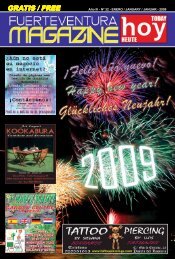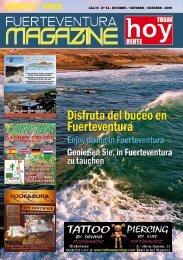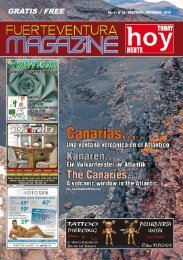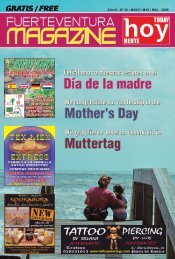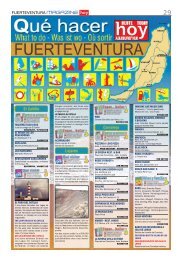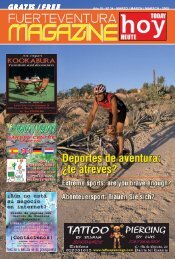GRATIS / FREE - fuerteventura magazine hoy
GRATIS / FREE - fuerteventura magazine hoy
GRATIS / FREE - fuerteventura magazine hoy
Create successful ePaper yourself
Turn your PDF publications into a flip-book with our unique Google optimized e-Paper software.
FUERTEVENTURA MAGAZINE <strong>hoy</strong><br />
PORTADA / FRONT COVER / DAS TITELbILD<br />
The Canarian Banana<br />
FMHOY - Platanodecanarias.net<br />
Banana growing gets its origins from South East<br />
Asia, between India and Malaysia. Around 500<br />
years A.D., it arrived in Africa through Madagascar<br />
and during the 6th century it developed on the Mediterranean<br />
coasts and reached the Canary Islands<br />
from Guinea with Portuguese conquests in Africa.<br />
It is believed that the Spanish then introduced the<br />
banana from the Canaries to America.<br />
WHY ARE THE fLAvoUR AND PRoPERTIES of<br />
THE CANARIAN BANANA So DIffERENT fRoM<br />
THE CoMMoN BANANA?<br />
Amongst the main differences, the Canarian Banana<br />
has a greater degree of ripeness and can stay<br />
longer on the tree than the tropical banana because<br />
of the closeness between the banana farms and the<br />
consumers.<br />
Furthermore, the Canarian Banana has a higher<br />
humidity rate which means that is has a lot more<br />
flavour that the Common Banana which is dryer.<br />
The carbohydrates, soluble sugars and sucrose<br />
contained in the Common Banana are slightly higher<br />
which explains its more floury texture than the Canarian<br />
Banana which also contains more potassium.<br />
Finally, the climate of the Canary Islands is more<br />
variable than in Tropical Countries, which lengthens<br />
the maturity process of the Canarian Banana in the<br />
tree (6 months) compared to the common Banana<br />
(3 months) and results in greater levels of maturity,<br />
flavour and aroma.<br />
Sources: Estudio nutricional del Plátano de Canarias<br />
(Nutritional study of the Canarian Banana),<br />
University of Navarre, Department of Physiology and<br />
Nutrition. Estudio comparativo del valor nutritivo del<br />
plátano canario y la banana americana (Comparative<br />
study of the nutritional value of the Canarian Banana<br />
and the American Banana), The Complutense University<br />
of Madrid – Faculty of Pharmacy, Department of<br />
Nutrition and Bromatology II.<br />
CANARIAN BANANA fARMING<br />
The banana tree is a monocotyledon plant from the<br />
Musa family. The main varieties that are cultivated<br />
in the Canary Islands are a triploid from the Musa<br />
Acuminata species.<br />
The optimum temperature for banana tree farming<br />
is around 25ºC and the altitude should stay under<br />
300 metres, those conditions can only be found in the<br />
Canary Islands. Furthermore the banana tree requires<br />
good luminosity, a fair amount of humidity and soil<br />
with a sandy texture but that contains enough clay<br />
and silt, good porosity and an acidic PH.<br />
It takes about 10-12 months to go from the seeding<br />
process of the mother plant to getting the first bunch.<br />
13<br />
Once the bunch has been produced, the processes of<br />
tying, bagging and deflowering take place.<br />
The tying is carried out in order to protect the plant<br />
and stop it from falling because of the weight of the<br />
bunch and the wind. The bagging of the bunch consists<br />
in wrapping it in a plastic bag ensuring that the<br />
fruit will fill in a uniform manner and protect it from<br />
plague attacks and rubbing damage during harvest<br />
and transport. The deflowering process consists in<br />
taking away by hand one by one the female flowers<br />
(which creates the banana) from each fruit.



